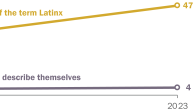The Pew Hispanic Center, a project of the Pew Research Center, today released five additional demographic profiles of Hispanic populations in the United States by country of origin: Guatemalan, Colombian, Honduran, Ecuadorian and Peruvian.These five follow the release earlier this year of demographic profiles for the five largest Hispanic populations: Mexican, Puerto Rican, Cuban, Salvadoran, and Dominican.1
More than six-in-ten Hispanics in the U.S. self-identify as being of Mexican origin. Nine of the other 10 largest Hispanic origin groups — Puerto Rican, Cuban, Salvadoran, Dominican, Guatemalan, Colombian, Honduran, Ecuadorian and Peruvian — account for about a third of the U.S. Hispanic population. There are differences across these 10 population groups in the share of each that is foreign born, citizen (by birth or naturalization), and proficient in English. They are also of varying age, tend to live in different areas within the U.S, and have varying levels of education, homeownership rates, and poverty rates.
These profiles of the 10 largest Hispanic populations in the U.S. describe the employment and income characteristics of each group. Characteristics of each group are also contrasted with the characteristics of all Hispanics and with the U.S. population overall. The profiles are based on the Center’s tabulations of the Census Bureau’s 2007 American Community Survey (ACS).
The newly released profiles include:
Guatemalan-Americans This statistical profile describes the demographic, employment and income characteristics of the Guatemalan-American population in the United States. The characteristics of Guatemalans are contrasted with the characteristics of all Hispanics and the U.S. population overall.
Colombian-Americans This statistical profile describes the demographic, employment and income characteristics of the Colombian-American population in the United States. The characteristics of Colombians are contrasted with the characteristics of all Hispanics and the U.S. population overall.
Honduran-Americans This statistical profile describes the demographic, employment and income characteristics of the Honduran-American population in the United States. The characteristics of Hondurans are contrasted with the characteristics of all Hispanics and the U.S. population overall.
Ecuadorian-Americans This statistical profile describes the demographic, employment and income characteristics of the Ecuadorian-American population in the United States. The characteristics of Ecuadorians are contrasted with the characteristics of all Hispanics and the U.S. population overall.
Peruvian-Americans This statistical profile describes the demographic, employment and income characteristics of the Peruvian-American population in the United States. The characteristics of Peruvians are contrasted with the characteristics of all Hispanics and the U.S. population overall.
All 10 demographic profiles are available at the Pew Hispanic Center’s website.
1. The demographic profiles of Mexicans, Cubans, Salvadorans and Dominicans were released in September. The demographic profile of Puerto Ricans in the 50 U.S. states and the District of Columbia was released in July. Country of origin is self-described in response to the Hispanic origin question in the ACS. It is not necessarily the same as place of birth. For example, a person born in Los Angeles may identify his or her country of origin as Mexico. Likewise, some people born in Mexico may identify another country as their origin depending on the place of birth of their ancestors.

